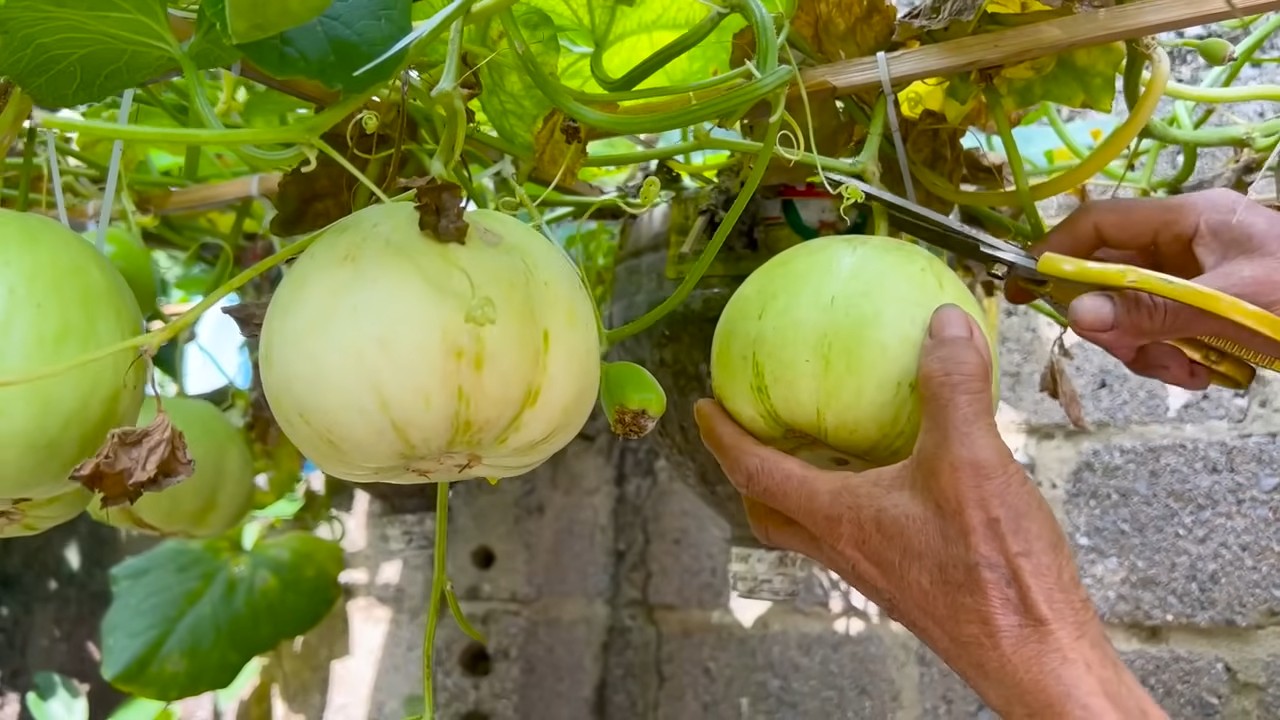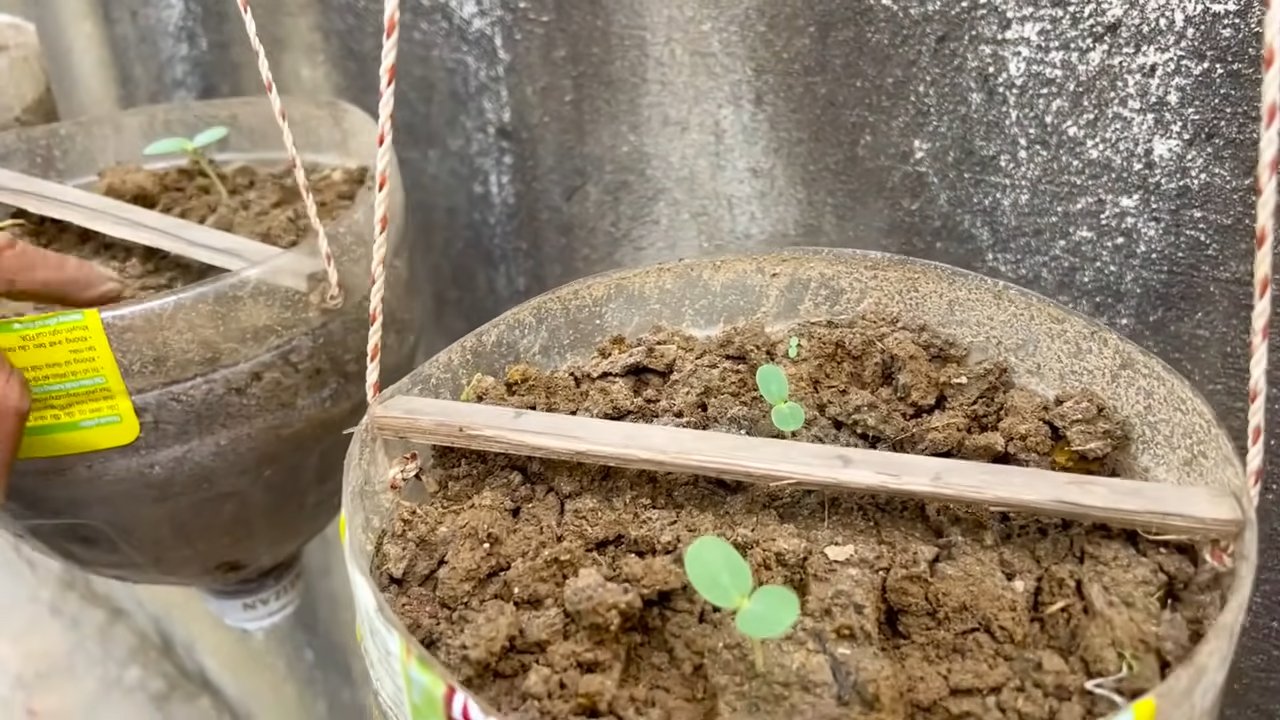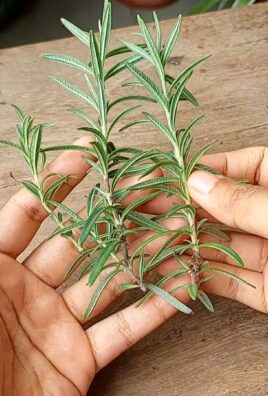Double Melon Harvest Hack: Imagine biting into not one, but two juicy, sun-ripened melons from your very own garden! Sounds like a dream, right? Well, it doesn’t have to be! For centuries, gardeners have sought ways to maximize their yields, and while some methods are complex, I’m here to share a simple, yet incredibly effective, DIY trick that can potentially double your melon harvest.
Melons, symbols of summer abundance and sweet refreshment, have been cultivated for thousands of years, tracing back to ancient Africa and Asia. Their journey across continents speaks to our enduring desire for these delectable fruits. But let’s face it, growing melons can sometimes feel like a gamble. Pests, diseases, and unpredictable weather can all conspire to limit your bounty. That’s where this double melon harvest hack comes in!
This DIY article will guide you through a straightforward technique that encourages your melon plants to produce more fruit. Whether you’re a seasoned gardener or just starting out, this hack is easy to implement and requires minimal effort. I’ll show you how to give your melon plants the boost they need to thrive, ensuring you’ll be enjoying a truly bountiful harvest this season. Get ready to impress your friends and family with your melon-growing prowess!

Double Your Melon Harvest: A DIY Trellising Guide
Hey fellow gardeners! Are you dreaming of a bumper crop of juicy melons but struggling with limited space or dealing with pesky ground pests? I’ve got a game-changer for you: vertical melon trellising! This method not only doubles your potential harvest in the same footprint but also keeps your precious melons off the ground, preventing rot and making them easier to manage. I’m going to walk you through exactly how I do it, so you can enjoy a melon bonanza too!
Choosing the Right Melon Variety
Before we dive into the construction, let’s talk melons. Not all melons are created equal when it comes to trellising. Smaller varieties are your best bet. Think:
* Cantaloupe: These are generally a good size for trellising, especially smaller varieties like ‘Minnesota Midget’.
* Honeydew: Similar to cantaloupe, choose smaller, compact varieties.
* Watermelon: This is where it gets tricky. Stick to *very* small, personal-sized watermelons like ‘Sugar Baby’ or ‘Bush Sugar Baby’. Larger watermelons will be too heavy for most trellises, even with support.
* Other Melons: Consider Armenian cucumbers (which are technically melons!), or other smaller, less common varieties.
Important Note: Always check the seed packet or plant label for the mature size and weight of the melon. This will help you choose the right trellis and support system.
Building Your Melon Trellis
Okay, let’s get our hands dirty! There are a few different ways to build a melon trellis, but I’m going to share my favorite method, which is sturdy, relatively inexpensive, and easy to customize.
Materials You’ll Need:
* Wooden Posts: 4×4 lumber, at least 8 feet long. You’ll need two of these for the main supports.
* Horizontal Supports: 2×4 lumber, the length will depend on how wide you want your trellis. I usually go for 6-8 feet. You’ll need at least two of these.
* Wire Mesh or Netting: Choose a mesh with openings large enough for you to reach through and harvest your melons. Hardware cloth, cattle panels, or heavy-duty garden netting all work well. The length and width will depend on the size of your trellis.
* Fasteners: Deck screws (various sizes), staples (if using netting), and zip ties.
* Tools: Saw, drill, level, measuring tape, staple gun (if using netting), wire cutters (if using wire mesh).
* Optional: Wood stain or sealant to protect the wood from the elements.
Step-by-Step Instructions:
1. Prepare the Posts: If you’re using untreated lumber, I highly recommend applying a wood stain or sealant to protect it from rot. Let it dry completely before moving on. This will significantly extend the life of your trellis.
2. Set the Posts: Dig two holes about 2-3 feet deep, spaced the desired width of your trellis apart (remember those 2×4 horizontal supports?). Place the posts in the holes and backfill with soil, tamping it down firmly. Use a level to ensure the posts are perfectly vertical. This is crucial for the stability of your trellis.
3. Attach the Horizontal Supports: Using deck screws, attach the 2×4 horizontal supports to the posts. One should be near the top of the posts, and the other about 1-2 feet from the ground. Make sure they are level! These supports will provide the framework for your mesh or netting.
4. Attach the Wire Mesh or Netting: This is where you’ll create the climbing surface for your melons.
* For Wire Mesh: Use wire cutters to cut the mesh to the desired size. Attach it to the wooden frame using heavy-duty staples or U-nails. Make sure the mesh is taut and secure.
* For Netting: Stretch the netting across the frame and secure it with staples. Again, make sure it’s taut to provide good support for the melon vines.
5. Reinforce the Trellis (Optional): For extra stability, especially if you’re planning on growing heavier melons, you can add diagonal braces between the posts and the horizontal supports. This will prevent the trellis from swaying or collapsing under the weight of the melons.
Planting and Training Your Melon Vines
Now for the fun part: planting!
1. Prepare the Soil: Melons are heavy feeders, so make sure your soil is rich in organic matter. Amend the soil with compost or well-rotted manure before planting. Good drainage is also essential.
2. Plant Your Melon Seedlings: Plant your melon seedlings at the base of the trellis, spacing them according to the instructions on the seed packet. I usually plant 2-3 seedlings per trellis.
3. Water Thoroughly: Water the seedlings well after planting.
4. Training the Vines: As the melon vines grow, you’ll need to train them to climb the trellis. Gently guide the vines towards the mesh or netting and use zip ties or soft plant ties to secure them. Be careful not to damage the vines.
5. Pruning (Optional): Some gardeners like to prune their melon vines to encourage fruit production. You can remove some of the side shoots to direct the plant’s energy towards the main vines. However, this is not essential.
Supporting Your Growing Melons
This is arguably the most important part of trellising melons. As the melons grow, they’ll become heavy and need extra support to prevent them from breaking off the vine.
Here’s what I do:
1. Fabric Slings: Cut squares of old t-shirts, burlap, or pantyhose (yes, really!). The size of the square will depend on the size of the melon.
2. Create the Sling: Gently cradle the melon in the fabric square. Gather the corners of the fabric together above the melon.
3. Attach the Sling to the Trellis: Use zip ties or twine to attach the gathered fabric to the trellis. Make sure the sling is snug but not too tight. You want to support the melon without constricting it.
4. Adjust as Needed: As the melon grows, you may need to adjust the sling to provide more support.
Alternative Support Methods:
* Netting Bags: You can also purchase pre-made netting bags specifically designed for supporting melons.
* Plastic Containers: Cut the bottom off a plastic container and use it as a cradle for the melon. Secure it to the trellis with zip ties.
Watering and Fertilizing
Melons need consistent watering, especially during hot weather. Water deeply at the base of the plant, avoiding wetting the foliage. I like to use a soaker hose or drip irrigation to deliver water directly to the roots.
Fertilize your melon plants every 2-3 weeks with a balanced fertilizer. You can also use a liquid seaweed fertilizer to provide essential micronutrients.
Pest and Disease Control
Keep an eye out for common melon pests like squash bugs, aphids, and cucumber beetles. Hand-picking pests, using insecticidal soap, or applying neem oil can help control infestations.
To prevent fungal diseases, ensure good air circulation around the plants and avoid overhead watering. If you notice any signs of disease, treat with a fungicide.
Harvesting Your Melons
The moment you’ve been waiting for! Knowing when to harvest your melons is key to enjoying their full flavor.
Here are some tips:
* Cantaloupe: The stem will start to slip easily from the melon when it’s ripe. The skin will also turn a golden color and have a fragrant aroma.
* Honeydew: The skin will turn a creamy yellow color and feel slightly waxy. The blossom end will also be slightly soft.
* Watermelon: The tendril closest to the melon will turn brown and dry. The underside of the melon (where it rests on the ground or sling) will turn a creamy yellow color. You can also thump the melon – a ripe watermelon will sound hollow.
Once your melons are ripe, carefully cut them from the vine with a sharp knife. Enjoy the fruits (literally!) of your labor!
Troubleshooting
* Melons are falling off the vine before they ripen: This could be due to insufficient support, inadequate watering, or nutrient deficiencies. Make sure your slings are providing adequate support, water regularly, and fertilize as needed.
* Vines are not climbing the trellis: Gently guide the vines towards the trellis and secure them with zip ties or plant ties.
* Pests are attacking my melons: Identify the pest and use appropriate control measures, such as hand-picking, insecticidal soap, or neem oil.
Vertical melon trellising is a rewarding project that can significantly increase your harvest and improve the health of your plants. With a little effort and planning, you can enjoy a bountiful crop

Conclusion
So, there you have it! The “Double Melon Harvest Hack” isn’t just a clever trick; it’s a game-changer for anyone serious about maximizing their melon yield. We’ve walked you through the simple steps, explained the science behind it, and hopefully, inspired you to give it a try.
Why is this a must-try? Because it’s efficient, cost-effective, and, most importantly, it works! Imagine doubling your melon harvest without significantly increasing your workload or garden space. Think of all the delicious melon salads, refreshing smoothies, and sweet treats you can create with your bumper crop. This hack empowers you to become a more productive and resourceful gardener.
But don’t stop there! Feel free to experiment with variations. For example, you could try different types of supports for your melons as they grow larger. Some gardeners prefer slings made from old t-shirts, while others opt for commercially available melon cradles. The key is to provide adequate support to prevent the vine from breaking under the weight of the developing fruit.
Another variation to consider is the timing of the hack. While we recommend implementing it when the melons are roughly tennis ball-sized, you can adjust this based on your specific melon variety and growing conditions. Observe your plants closely and adapt the technique as needed.
Furthermore, consider the nutrient needs of your melon plants. With a doubled harvest, they’ll require more resources. Ensure you’re providing adequate fertilization throughout the growing season, paying particular attention to potassium and phosphorus, which are essential for fruit development. You might also want to amend the soil with compost or other organic matter to improve its water-holding capacity and nutrient content.
We are confident that the “Double Melon Harvest Hack” will revolutionize your melon growing experience. It’s a simple yet powerful technique that can significantly increase your yield and allow you to enjoy more of these delicious fruits.
Now, it’s your turn! We encourage you to try this DIY trick in your own garden and share your results with us. Post photos of your doubled melon harvest on social media using #DoubleMelonHarvestHack and tag us so we can see your success. We’re eager to hear about your experiences, any variations you’ve tried, and any tips you’ve discovered along the way. Let’s build a community of melon-loving gardeners who are passionate about maximizing their harvests!
Remember, gardening is all about experimentation and learning. Don’t be afraid to try new things and adapt techniques to suit your specific needs and conditions. With a little effort and the “Double Melon Harvest Hack,” you’ll be well on your way to enjoying a bountiful melon harvest this season. Happy gardening!
Frequently Asked Questions (FAQ)
What exactly is the “Double Melon Harvest Hack”?
The “Double Melon Harvest Hack” is a simple gardening technique designed to increase the yield of your melon plants. It involves strategically supporting the developing melons to prevent vine breakage and encourage the plant to produce more fruit. By providing support, you allow the plant to focus its energy on growing more melons instead of struggling to support the weight of existing ones.
What types of melons does this hack work best for?
This hack is effective for a wide variety of melons, including watermelons, cantaloupes, honeydew melons, and even smaller varieties like sugar baby watermelons. The key is to ensure that the support system you use is appropriate for the size and weight of the melons you’re growing. Larger melons will require sturdier support than smaller ones.
When is the best time to implement the “Double Melon Harvest Hack”?
The ideal time to implement this hack is when the melons are roughly the size of a tennis ball. At this stage, they’re large enough to be easily supported but not so heavy that they’re likely to cause vine breakage before you can provide support. However, you can adjust the timing based on your specific melon variety and growing conditions. Observe your plants closely and implement the hack when you see the melons starting to develop and put strain on the vines.
What materials do I need to implement this hack?
You’ll need some type of support system for the melons. This could include:
* Slings made from old t-shirts or fabric scraps: These are a cost-effective and readily available option.
* Commercial melon cradles: These are specifically designed to support melons and are available at most garden centers.
* Netting or mesh bags: These can be used to create slings or supports for smaller melons.
* Twine or rope: This can be used to secure the supports to the trellis or other support structure.
* Stakes or trellises: These provide a framework for supporting the vines and melons.
How do I create a sling for my melons?
Creating a sling is simple. Cut a piece of fabric (an old t-shirt works well) into a square or rectangle. The size of the fabric will depend on the size of the melon you’re supporting. Place the melon in the center of the fabric and gather the edges together. Tie the edges securely to a trellis, stake, or other support structure. Make sure the sling is snug enough to support the melon but not so tight that it restricts its growth.
Will this hack work in all climates?
The “Double Melon Harvest Hack” can be implemented in most climates where melons can be successfully grown. However, you may need to adjust the technique based on your specific climate and growing conditions. For example, in hot, sunny climates, you may need to provide shade for the melons to prevent sunburn. In cooler climates, you may need to start your melons indoors to give them a head start.
Can I use this hack in a container garden?
Yes, this hack can be used in a container garden, but you’ll need to choose a container that is large enough to accommodate the melon plant and its developing fruit. You’ll also need to provide adequate support for the vines and melons. Consider using a trellis or other support structure that can be easily attached to the container.
What if my melon vines are already broken?
If your melon vines are already broken, it may be too late to implement the “Double Melon Harvest Hack” for those specific melons. However, you can still try to salvage the situation by carefully supporting the broken vine and the developing melon. You may also want to consider pruning the broken vine to encourage the plant to focus its energy on growing other melons.
How much extra fertilizer should I use with this hack?
With a doubled harvest, your melon plants will require more nutrients. Increase your fertilizer application by approximately 25-50%, depending on the fertility of your soil. Use a balanced fertilizer that is specifically formulated for fruiting plants. Pay particular attention to potassium and phosphorus, which are essential for fruit development. Monitor your plants closely and adjust the fertilizer application as needed.
Is the “Double Melon Harvest Hack” guaranteed to double my melon harvest?
While this hack is designed to increase your melon yield, there’s no guarantee that it will exactly double your harvest. The actual increase in yield will depend on a variety of factors, including the variety of melon you’re growing, your growing conditions, and your overall gardening practices. However, by implementing this hack, you can significantly improve your chances of enjoying a more bountiful melon harvest.




Leave a Comment